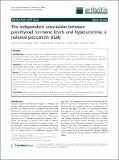| dc.contributor.author | Hui, Janet Y | |
| dc.contributor.author | Zhang, Yuqing | |
| dc.contributor.author | Choi, Hyon K | |
| dc.contributor.author | Choi, Jee Woong | |
| dc.contributor.author | Mount, David Bruce | |
| dc.contributor.author | Zhu, Yanyan | |
| dc.date.accessioned | 2013-03-19T20:27:12Z | |
| dc.date.issued | 2012 | |
| dc.identifier.citation | Hui, Janet Y, Jee Woong J Choi, David B Mount, Yanyan Zhu, Yuqing Zhang, and Hyon K Choi. 2012. The independent association between parathyroid hormone levels and hyperuricemia: a national population study. Arthritis Research & Therapy 14(2): R56. | en_US |
| dc.identifier.issn | 1478-6354 | en_US |
| dc.identifier.uri | http://nrs.harvard.edu/urn-3:HUL.InstRepos:10448732 | |
| dc.description.abstract | Introduction: Increased frequencies of hyperuricemia and gout have been associated with primary hyperparathyroidism, and recent clinical trials of parathyroid hormone (PTH) have reported hyperuricemic adverse events. We evaluated the potential population impact of PTH on serum uric acid (SUA) levels by using a nationally representative sample of United States adults. Methods: By using data from 8,316 participants aged 18 years and older in the National Health and Nutrition Examination Survey 2003 to 2006, we examined the relation between serum PTH and SUA levels with weighted linear regression. Additionally, we examined the relation with hyperuricemia by using weighted logistic regression. Results: SUA levels increased with increasing serum PTH concentration. After adjusting for age, sex, dietary factors, glomerular filtration rate (GFR), and other potentially related biomarkers (calcium, phosphorus, alkaline-phosphatase, 25-hydroxyvitamin D), the SUA level differences from the bottom (referent) to top quintiles of serum PTH levels were 0, 8, 13, 14, and 19 μM (95% CI, 12 to 26; P for trend, < 0.001). These estimates were larger among renally impaired individuals (multivariate SUA difference between the extreme quintiles of PTH, 26 versus 15 μM among those with GFR ≥ 60 versus < 60 ml/min per 1.73 m2, respectively) (P for interaction = 0.004). The odds of hyperuricemia by various definitions increased with increasing PTH levels as well (multivariate P values for trend, < 0.05). Conclusions: These nationally representative data indicate that serum PTH levels are independently associated with serum uric acid levels and the frequency of hyperuricemia at the population level. | en_US |
| dc.language.iso | en_US | en_US |
| dc.publisher | BioMed Central | en_US |
| dc.relation.isversionof | doi:10.1186/ar3769 | en_US |
| dc.relation.hasversion | http://www.ncbi.nlm.nih.gov/pmc/articles/PMC3446422/pdf/ | en_US |
| dash.license | LAA | |
| dc.title | The independent association between parathyroid hormone levels and hyperuricemia: a national population study | en_US |
| dc.type | Journal Article | en_US |
| dc.description.version | Version of Record | en_US |
| dc.relation.journal | Arthritis Research & Therapy | en_US |
| dash.depositing.author | Mount, David Bruce | |
| dc.date.available | 2013-03-19T20:27:12Z | |
| dc.identifier.doi | 10.1186/ar3769 | * |
| dash.authorsordered | false | |
| dash.contributor.affiliated | Mount, David | |
| dash.contributor.affiliated | Choi, Jee Woong | |
| dash.contributor.affiliated | Zhu, Yanyan | |


